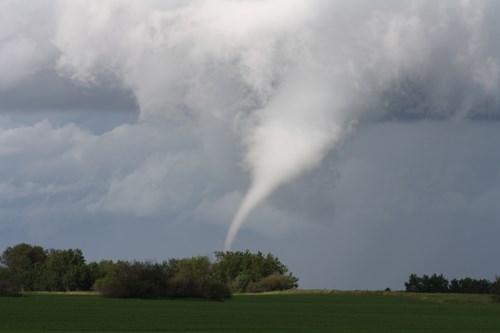With the summer upon us, storms are likely to follow. Thunderstorms that carry hail, lightning, and possibly even tornadoes are more likely during the summer months than any other.
"While the weather is often unpredictable, it's fairly safe to say that all Canadians will experience a moderate to severe weather event in their area sometime this season," said David Phillips, senior climatologist, Environment Canada. "Therefore, it's important to remind Canadians that they should be prepared wherever they might live."
Though these are forces of nature and cannot be controlled, often they are predicted and weather warnings are released.
But, what do you do when severe weather is forecast? You follow precautionary measures and learn how to react under different circumstances.
The Government of Canada maintains a website that holds helpful hints for what to do when severe weather affects you, http://www.getprepared.gc.ca.
Quick tips for how to handle these forces of nature can be found below.
Thunderstorms can involve high winds, hail, lightning, heavy rain, and tornadoes. When dealing with them it is suggested to unplug electronics and keep away from objects that conduct electricity. This includes everything from telephones to bathtubs, though cell phones do not pose the same issues as landlines.
If hail is forecast people are encouraged to cover plants or move vehicles into a garage right away, as once it begins to fall going outside may be dangerous. In Canada no one has yet died from injuries sustained during a hail storm, but hail can fall at tremendous speeds. Ranging from the size of a pea to a grapefruit one can be hit with extreme force, which can cause injury. While inside it is ideal to keep away from windows and skylights, just in case the hail breaks through.
Lightning is another concern during thunderstorms. It is extremely unlikely to be hit by lightning, but has happened to people around the world. Other dangers are involved with this phenomenon, however, including knocking down trees or starting wildfires.
The best way to deal with a wildfire, whether caused by lightning or not, is to have a fire escape plan. This would include maintaining smoke detectors on every floor of the home and keeping easy access to a good sprinkler. If a fire is moving your way, but is not an imminent threat then after calling it in one can move combustibles away from the house and shut off any propane or natural gas. The sprinkler can then be used to soak the house. Then evacuate pets and family if the fire continues to advance.
Finally a major concern regarding thunderstorms, especially supercell thunderstorms, are tornadoes. Warning signs can be seen in the sky during a storm, which includes an extremely dark sky highlighted by greenish/yellowish clouds. Funnel clouds may form at the rear base of the cumulonimbus cloud. A rumbling or whistling sound is also associated with tornado formation.
It is best to take shelter in a basement or a small interior room on the ground floor, such as a bathroom or closet. Stay away from windows, outside walls, and doors. No matter what no one should chase a tornado. They are unpredictable, changing course unexpectedly, and may appear to be still while actually advancing towards you.
So as the summer is now here enjoy the sunshine and hot weather, but remember to stay safe. If it looks like a storm is coming, take a few precautions just in case.



